
Charles Rolls was the first Englishman to be killed in an air crash. He was thirty years old. Rolls’ death shocked the country and made headlines across the world. His relative youth at the time is perhaps the reason that he is a forgotten hero; a man who today receives little credit for the legacy that he left behind, even though at the time of his death on July 12th 1910 he was one of the most famous men in the country. His loss was regarded as a national tragedy. Today he is most famous for the partnership he forged with Henry Royce to form Rolls-Royce, a name that is now as synonymous with excellence as it was then. Yet Rolls was a national hero long before he met Royce in Manchester in 1904.The son of a peer, Rolls was one of the first, and certainly the youngest of Britain’s pioneer motorists. He was a successful racing driver and achieved what many believed impossible – selling the motor car to Britain.With the reliability of the car achieved, Rolls immersed himself in conquering the next great frontier, the air. He made his first ascent in a balloon in 1898 and was experimenting with the possibilities of powered flight as early as 1901.One of the first Britons to fly, he made the first return crossing of the Channel in 1909 in a Wright Flyer and was acclaimed across the world. Charles Rolls was an enigma, a man of great paradox, and yet he was a great patriot, racing driver, record breaker, aviator, one of the United Kingdom’s great industrialists, a pioneer in the true sense of the word and he had a prophetic ability to see the way of the future. This biography quotes extensively from the writings of Charles Rolls himself and from contemporary accounts of the events during those pioneer days of motoring and aviation. It is illustrated by many previously unpublished photographs from the Rolls Family albums.
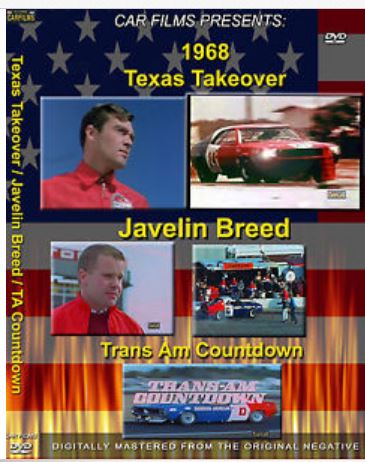
3 racing FILMS 1 DVD
TEXAS TAKEOVER
This color film, documenting the record-breaking performance of Craig Breedlove and the American Motors AMX, has been completely restored from the original neg. (This is it folks! It doesn’t get any better than this.) We spent hours at one of the top post houses in Hollywood restoring this historic film. If you are an AMC fan, this collector-quality dvd is a must. Craig’s co-driver on this run was his wife, Lee Breedlove. On February 4, 1968, Breedlove set a new 24-hour world record stock car endurance run of 3378 miles, averaging over 140 MPH, running day and night–a fine testament to the engineering and durability of the new AMX!
TRANS AM COUNTDOWN
This film has not been seen since 1970, a promo film made for the AMC Javelin team focusing on a young Mark Donohue and Rodger Penske–lots of unseen track footage! On track you will see an unusual combination of cars running together in practice like Mark’s Javelin being passed by a Porsche 917 and the Javelin passing some really exotic cars like Ferrari’s Trans Am. Countdown was transfeRred directly from the 16mm original negative. It looks like it was shot yesterday.
JAVELIN BREED
The story of the 1968 Trans-Am Racing Series season, with the AMC drivers George Follmer and Peter Revson and crew chief Ronnie Kaplan. This was AMC’s first try into the racing field and they were very impressive, finishing every race. Over 20 minutes of color footage showing the AMC vs. Mustang duels. Lots of race coverage and shots of many other cars of the era.

For most of us, most of the time, the roads we travel are largely forgotten once we get to where we’re going. By day, they usually reveal a familiar, real—living—world. But then darkness comes. Haunted Highways brings together more than twenty of the spookiest stories ever of ghosts, hauntings, and supernatural events on or near America’s highways and byways. There are the usual suspects—the creepy hitchhiker, the eerie lights along a lonely stretch of road—as well as many you never dared to imagine.
Each of the book’s more than twenty-five chapters ratchets up the suspense, from an introduction that sets the scene and draws you in, to a haunting climax. Whether the actor Telly Savalas’s haunting encounter with a long-dead good Samaritan on a rural Long Island road, or the Ghost Riders in the Sky who appear over the plains of Texas, these stories will bring delightful fright to readers young and old.
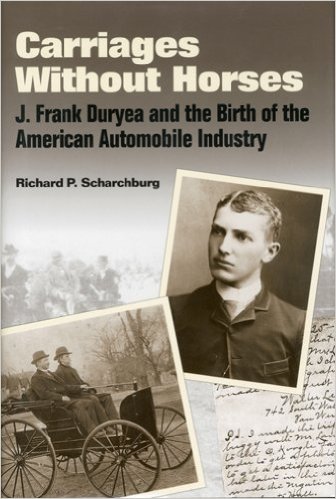
In September 1893, little could 23-year-old mechanic J. Frank Duryea dream of the changes that would be brought about by his creation – a frail gasoline buggy that made its debut on the streets of Springfield, Massachusetts. ‘When I began work upon the horseless carriage back in 1892, no one could see what the automobile would mean to my fellow beings in peace or in war. And yet, the automobile to this very day contains not a few of the fundamental features which I was the first to devise, design, build, or order built to my specifications.’ – J. Frank Duryea (1942) ‘What we have is a family feud – without the violence – rivaling the legendary Hatfields and McCoys.’ Charles E. and J. Frank Duryea, two brothers from rural Illinois, were the founders of the American automobile industry. The Duryea Motor Wagon company was the first company organized in the United States for the manufacture of automobiles. The attention-getting, older brother Charles demanded – and to date has received – the principal credit for these pioneering accomplishments. A bitter family feud between the brothers, which was even carried on by their families after their deaths, further muddied the question about the individual brothers’ contributions. However, in Carriages Without Horses: J. Frank Duryea and the Birth of the American Automobile Industry, historian and author Richard P. Scharchburg proves that the quiet, self-effacing younger brother J. Frank Duryea is unquestionably entitled to as much credit as Charles, if not considerably more. J. Frank did the actual work of construction on the cars, and was responsible for the practical designing and engineering of all components (aside from the steering mechanism) of the Duryea cars. More than an account of the struggle for precedence between brothers, however, Carriages Without Horses tells the story of America’s first automobile company taking shape. Scharchburg covers the design and development of the first Duryea car, culminating with its successful operation on the streets of Springfield, Massachusetts on September 21, 1893. This book also covers: the landmark Chicago Times-Herald race of 1895, won by the Duryea car built and driven by J. Frank; the subsequent progress of the Duryea Motor Wagon Company; and, after the brothers went their separate ways, J. Frank’s 1901 founding of the Stevens-Duryea Company.
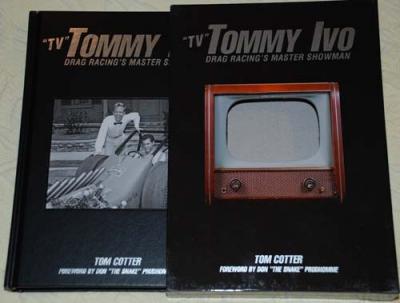
SOLD OUT
“Special Limited edition of 200 very cool TV slipcase books. signed and numbered.
Signed by Tommy Ivo, Don (the Snake) Prudhomme and the author, Tom Cotter.
In the early 1960s, Tommy Ivo had the world in the palm of his hands. Still a young man, he was already a star of television and film with a promising Hollywood future ahead of him. Then his producers told him he had to quit drag racing. He quit the entertainment industry instead.
This is the official story of Ivo’s incredible life and racing career. Readers will follow “TV” Tommy as he becomes the most ambitious drag racer in the nation, building his own cars in the garage behind his Burbank home; becoming the first driver to pilot his dragsters to 170, 175, and 180 miles per hour and towing his cars to match races at small-town drag strips across the United States. Always the showman, Ivo pioneered promotional techniques that are today taken for granted. In this regard especially, his impact on the sport cannot be understated, and his legacy is detailed in this incredible bio of one of drag racing’s most irrepressible characters.
“

New York City custom car and motorcycle culture has long been overshadowed by the left coast designers and machines. In this unprecedented book, urban anthropologist Michael McCabe presents the stories, innovators, and machines behind NYC car and motorcycle builders. He reveals an outsider’s tale filled with passion, creativity, and high-speed thrills. Based on a year’s worth of interviews and photo shoots with nearly 40 custom builders, McCabe offers unique access to their private, creative lives and impressive collections of machines in garages and workshops throughout the five boroughs. Legendary urban personalities like “Big Daddy” George LeBlanc, Mel Bernstein, and Dick Zigun tell the history of NYC horsepower, including nostalgia for the days of the NASCAR-sanctioned Weissglass Speedway on Staten Island, illegal street racing, car clubs, and shows. Voices from the groundswell of younger builders, like John Copeland, Sal Pepi, and Pete Ranko, complete this collection of oral histories and images and show respect for the city’s hands-on narrative. With nearly 800 images of custom cars and motorcycle, this history is ideal for builders, car collectors, and urban historians.
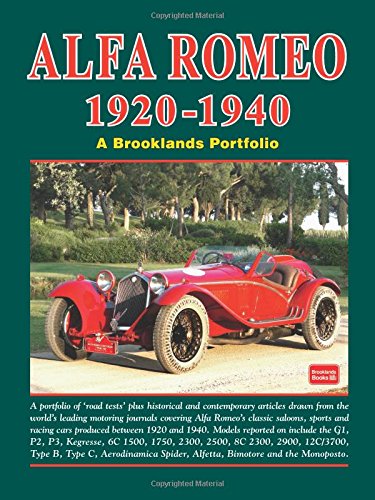
A portfolio of road tests plus historical and contemporary articles drawn from the world’s leading motoring journals covering Alfa Romeo’s classic saloons, sports and racing cars produced between 1920 and 1940. Models reported on include G1, P2, P3, Kegresse, 6C 1500, 1750, 2300, 2500, 8C 2300, 2900, 12C/3700, Type B, Type C, Aerodinamica Spider, Alfetta, Bimotore and the Monoposto. The company that became Alfa Romeo in 1920 was founded as Societa Anonima Italiana Darracq (SAID) in 1906 by the French automobile firm of Alexandre Darracq with the backing of some Italian investors. Sales slowed of these Italian Darracq’s and subsequently in 1909 a new company was founded named A.L.F.A. (Anonima Lombarda Fabbrica Automobili), initially still in partnership with Darracq. The first non-Darracq car, produced in 1910 by ALFA was the 24 HP, designed by their new employee, Giuseppe Merosi. It was a winner and sold 50 cars in its first year. In August 1915 the company came under the direction of Neapolitan entrepreneur Nicola Romeo, who, in 1915, went over to produce military hardware for the Italian and Allied war efforts. In 1920, the company name was changed to Alfa Romeo and car production started again with the Torpedo 20-30 HP which became the first car to carry the new logo. Their first success came that year when Giuseppe Campari won at Mugello and continued with second place in the Targa Florio driven by Enzo Ferrari. Giuseppe Merosi continued as head designer, and the company continued to produce solid road cars as well as successful race cars (including the 40-60 HP and the RL Targa Florio). In 1923 Vittorio Jano was lured away from Fiat, partly thanks to the persuasion of a young Alfa racing driver named Enzo Ferrari. He replaced Merosi as chief designer, who went on to Isotta Fraschini. The first Alfa Romeo under Jano was the P2 Grand Prix car, which in 1925 won the inaugural world championship for Grand Prix cars. For Alfa road cars Jano developed a series of small-to-medium-displacement 4-, 6-, and 8-cylinder inline power plants based on the P2 unit that established the classic architecture of Alfa engines. They featured light alloy construction, hemispherical combustion chambers, centrally located plugs, two rows of overhead valves per cylinder bank and dual overhead cams. These designs proved to be both reliable and powerful. Enzo Ferrari turned out to be a better team manager than driver, and when the factory team was privatised, it became Scuderia Ferrari. When Ferrari left Alfa Romeo, he went on to manufacture his own cars. Tazio Nuvolari often drove for Alfa during this period, winning many races for them prior to the Second World War. In 1928 Nicola Romeo left Alfa which soon afterwards went bankrupt when their defence contracts came to an end. Late in 1932 Alfa Romeo was rescued by the Italian government which took over effective control and Alfa which subsequently became a national emblem. During this period the company produced wonderfully successful sports cars which for many years excelled at Le Mans and built beautiful bespoke vehicles for the wealthy. The elegant bodies for these models were normally built by Touring of Milan or Carrozzeria Pinin Farina and era peaked with the legendary Alfa Romeo 2900B Type 35 racers. To put production figures into perspective, in the six years between 1934 and 1939, Alfa Romeo built 1994 cars, an average of 332 a year, a little less than one a day.
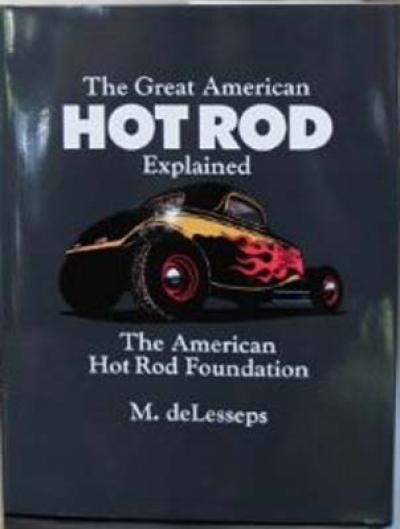
One of our early goals for the American Hot Rod Foundation was to publish a book that would attract young people to hot rodding. With so much focus on academics today, it’s easy to forget the practical skills, sheer fun, and the great friendships offered by this special hobby. We finally found the right author for our dream book, and it’s way better and appeals more broadly than we ever imagined. Whether you know nothing about the history and technology of hot rodding, or you’re a full-bore hot rodder today, you will love this book. Michael deLesseps is a lifetime rodder and car builder, a witty storyteller, and a fabulous artist. His wonderful book contains no photos – just sixty amazing watercolor diagrams and pictures! Perfect for children, teens, relatives and friends of rodders, people who are just curious, and anyone already in the hobby today. A beautiful, full-color hard-bound book, printed in America of course. Buy one for yourself, or share it as a gift!

Suddenly, everyone wants one of those old dirt bikes from back in the day. Knobby tires, small two-cycle engines, four-speed transmission, and a full four inches of suspension travel. Those are the bikes that most baby boomers grew up on; the ones that young men rode into the ground and left to rot where ever they last fell.
But no more. Now, those simple little Hondas, Yamahas, Harleys, and Pentons are making their way from the back of the garage to the front. From the barn to the shop. The shop where patient mechanics and enthusiasts are stripping them down and bringing them back to life.
The questions for the prospective buyer is: What to bring home? Among the thousands and thousands of dirt bikes, scramblers, trials bikes, play bikes and early motocross bikes, which are the best bikes to make your own?
Vintage Dirt Bikes will help the reader make that decision by providing information on all the most popular makes. For each bike, this new book provides four to six paragraphs describing the bike in general terms. In addition, bullet points for each model include the following information: Relative cost to acquire, value when finished, and which are most likely to offer the most fun for the money. Readers will also find what to look for when checking the condition of items such as paint, suspension, frame, and engine.
A general section at the back of the book will offer the reader help deciding where to buy classic bikes, where to get parts, who to call for help, and which parts of the restoration should be farmed out to experts with specific skills.
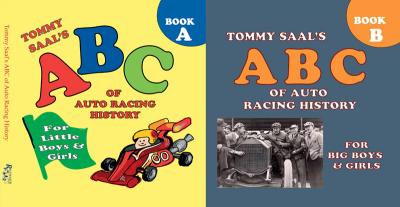
Here’s a book about auto racing history with a difference, one that’s written and illustrated to appeal to people of all ages even if they’re not racing fans in the first place. Tommy Saal’s ABC of Auto Racing History is unique in that it’s really two books in one. Book A features cartoons in color with versified captions to be read to or read by kids. The flip side is Book B that explains to young adults, racing neophytes and parents of kids with questions the stories behind B for Bonneville, D for Daytona, I for Indianapolis, L for Le Mans, S for Sebring and so on through the alphabet from A to Z without being too technical.
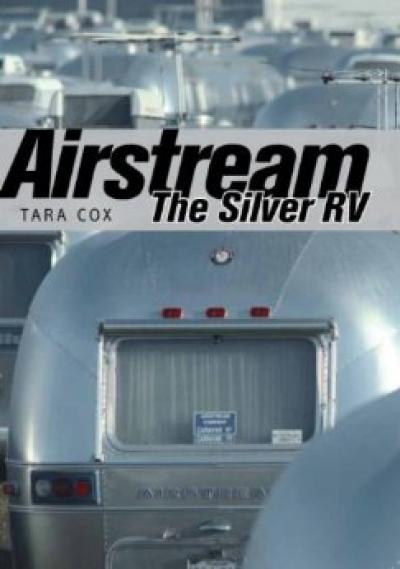
The Airstream is an eye-catching vintage classic. First appearing on American highways in the mid-1930s, these sleek aluminum icons were compact, cozy spaces that could hitched to the family car and taken out on the open road – and nearly a century later, their timeless design has lost none of its appeal, with the Airstream enjoying renewed popularity among celebrities, event planners and young travelers who appreciate its distinctively American blend of functionalism and beauty and air of nostalgia. Born in the California backyard of inventor Wally Byam and inspired by a trailer designed by Hawley Bowlus, the famed chief builder of The Spirit of St. Louis, the Airstream’s modernist aesthetic has remained relatively unchanged in eight decades, and its industrial durability has earned a reputation without peer, with more than 65% of all Airstreams still on the road today. The book features the complete history of the Airstream, tips, cool facts, quotes and fabulous photographs— a fitting tribute to a true American legend.
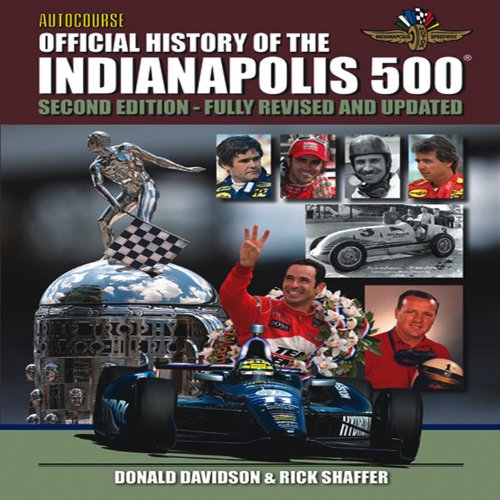
THE Indianapolis “500” is much more than merely the best known automobile race in the world. It is a cherished time-honored institution with a glorious history dating back more than one hundred years.
Known to most as, quite simply, “The 500,” it has been held every year since 1911, the only exceptions being 1917-18 and 1942-45, during the periods when America was involved in the two world wars.
Steeped in tradition, it has meant many things to many people and has played an enormous role in the lives of human beings, perhaps even more so for the spectators and devotees than for the participants themselves.
For over half a century, Memorial Day meant either trekking to the track or else ensuring that whatever other activity was planned for the day, a radio would always be within earshot. In more recent decades, settling down in front of the television has been added to the equation, while it is now the Sunday of Memorial Day weekend on which the extravaganza takes place, rather than on Memorial Day itself. But the feeling is the same.
For the participants, it has been a nearly 100-year saga of dreams, innovation, ingenuity, bravery, triumph, and tragedy. Paupers became millionaires, young men from small towns and broken homes became international celebrities, and regrettably, some of them gave their lives.
The “500” has endured world wars, depressions, recessions, political strife, and negative journalism, and yet it continues to draw massive passionate and emotional crowds, whose loyalty is rewarded with never-to-be-forgotten moments such as the finishes of 2006 and 2011, when Dan Wheldon snatched victory on literally the final turn.
This, then, is the story of the Indianapolis 500 and how it came to be. This is the story of more than 100 editions of the race, interspersed with a look at some of the compelling personalities, some little-known facts, an attempt to document the origins of some of the traditions, and perhaps even to dispel a few myths.
From Harroun to Franchitti, it’s all here…
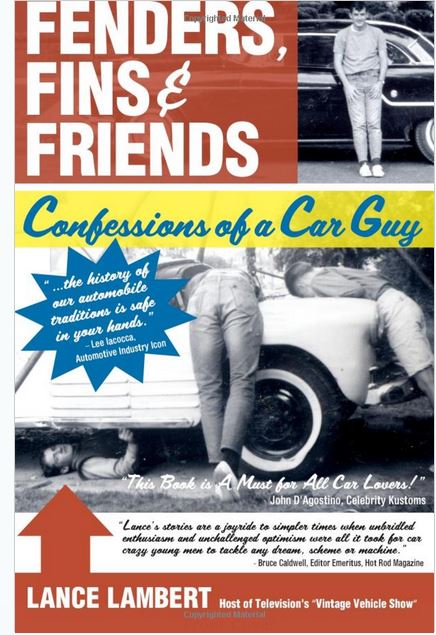
Every “car guy” has stories that elicit laughter, tears and admission of some bad choices.
Lance Lambert’s “Fenders, Fins & Friends: Confessions of a Car Guy” includes tales of riding in a 1939 ford as the steering wheel was removed and handed to him. Installing a siren in a 1955 Ford proved to be a bad decision. Putting five friends as far back as possible in a rock band’s van resulted in wheels stands and applause from admiring fans. Sitting in a 1949 Chevrolet while surrounded by five police cars and numerous guns pointed his direction caused some concern. “Fenders, Fins & Friends: Confessions of a Car Guy” reveals all that is good about the world of old cars and why being a Car Guy is the best way to enjoy life.
“…The history of our automobile traditions is safe in your hands.” Lee Iacocca, Automotive Industry Icon
“Lance’s stories are a joyride to simpler times when unbridled enthusiasm and unchallenged optimism were all it took for car crazy young men to tackle any dream, scheme or machine.” Bruce Caldwell, Editor Emeritus, Hot Rod Magazine
“Lance’s writings remind us of the sizzle that we were, or maybe could have been or wanted to be; his writings take us back to presumably simpler times of dreamy days, giving us peepholes back to the olden days. A great book from back in the day.” Don Weberg, Editor & Publisher, Garage Style Magazine
“Read this and you will gain insight into a down-to-earth soul, with a big heart, and an entertaining way of seeing the world.” Theresa Poalucci, Publisher, Journal Newspapers
“Lance’s humorous storytelling style makes you feel like you are sitting in the front seat with him as he drives you through his amazing ‘car guy’ life.” Sandy Scott, Director of Operations, Petersen Automotive Museum
“Lance Lambert is the Garrison Keillor of car stories. His nostalgic and chuckle worthy stories always put a smile on my face.” M.J. McDermott, KCPQ Television Reporter
“Lance is an amicable asset to the car world – at once a wealth of knowledge and history, an icon of automotive TV programming and a friendly ambassador to the industry for everyone from experienced gearheads to neophyte spectators. It is easy to see that Lance loves cars, and car people love Lance.” Heidi Van Horne, Automotive Reporter, Houston Chronicle
“…As a prolific writer, emcee and TV host, Lance is everybody’s ‘in the know’ and ‘go to’ car guy when they want the inside scoop. His stories are real and he has made it a point to document his adventures at every turn. His book is a ‘must read’ .” David Dickinson, Creator & Editor, “The Old Car Nut Book”
“This book is a ‘must read’ for all car lovers!” John D’Agostino, Celebrity Kustoms
“Compelling! ‘FENDERS, FINS & FRIENDS: Confessions of a car Guy’ provides a vivid and humorous look at 60 years of the memories of a true vintage vehicle legend. The vignettes are always evocative. A great read!” Kathleen Fullerton Bernhard, Ph.D., author of “The Invisible Woman”

SOLD OUT
NEW 2015 LIMITED EDITION Signed and Numbered
LIMITED EDITION “40” – Porsche 911 Turbo – Air Cooled Years 1975-1998 (published on 10.15.2015)
In spring 1975, the first Porsche 911 Turbo rolled to the dealers in the sales exhibition. Nearly 40 years later the car that changed the world, become a legend. “40” – Porsche 911 Turbo – Aircooled Years – tells the story of the sports car legend, starting with the prototype at the IAA 1973 and the last air-cooled 993 Turbo model year 1998. proved With the introduction of turbocharging in the standard sports cars that still young company Porsche their courage and innovativeness. The extraordinary success of the 911 Turbo contributed at the legendary sports car brand. In addition to mass-produced vehicles, the book is also intensively on special editions, such as the ten 930 Turbo S for Sonauto, the 964 Turbo Cabriolet, the 993 Turbo Cabriolet, or the 911 Turbo “package cars” from 1994, whose existence until today hardly anyone knows. The book was produced in close collaboration with the historical archive of Porsche AG and previously unpublished photographs showing. Rounding out this work is a detailed statistical part, to the internationally recognized Porsche expert Norbert Franz has created exclusive. Thus can be published for the first time the detailed numbers of each lot produced 911 Turbos. Furthermore, for the first time all the chassis numbers of original factory uprated vehicles are documented.
The second edition of the Porsche Turbo book “Aircooled Years 1975 – 1998″ has 70 extra pages and offers an even more detailed statistics section, created exclusively by internationally recognized Porsche expert Norbert Franz. For instance, it is now possible for the first time to publish the exact quantities of all the 911 Turbos ever produced, and, furthermore, all the chassis numbers of the original performance-enhanced vehicles (911 Turbo WLS) are documented for the very first time. In addition to the series-production vehicles, the book deals in detail with special series,such as the ten 930 Turbo S vehicles produced for Sonauto, the 964 Turbo Cabriolet, the 993 Turbo Cabriolet and the 911 Turbo “package cars” from 1994, whose existence is known only to a few even today.The book was written in close collaboration with the historical archive of Porsche AG and shows previously unpublished photographs of Porsche 911 Turbo Nr.1, which was driven by the daughter of Ferdinand Porsche, Louise Piech.
The book is published in a strictly limited edition of 2015 copies worldwide. Hardcover, 270 pages, German / English
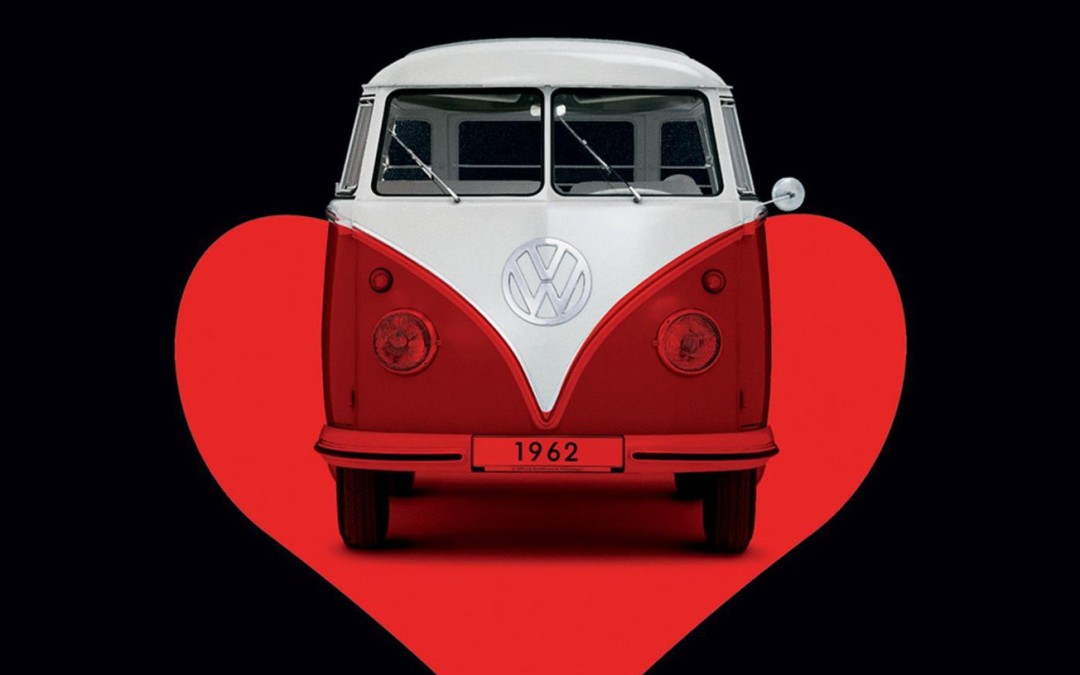
Whether hippie vehicle, work machine, camper van, family car or sought-after collector’s item: for fans of the Volkswagen Transporter or “Bulli” there really is nothing better.
On occasion of the world premiere of the brand new model, Volkswagen Transporter T6, and the 65th birthday of the Type 2, this book portrays the VW Bulli and its devotees. Apart from celebrities like Jacky Ickx or Johann Lafer Bulli Love presents Bulli fans from all over the world: an Indian Transporter enthusiast at the colourful Holi festival, a New York youngster, who earned his camper van by mowing lawns or the Tokyo trio with their T3 models.
Bulli Love combines wonderful reports from all over world with excellent photos of Bulli models and their owners. Pure passion, exceptionally staged, this is a magnum opus for one of the very few, unique automobiles of the world. A popular figure par excellence.
Autobooks-Aerobooks 2900 W. Magnolia Blvd. Burbank, CA 91505 (818) 845-0707 Hours: Tuesday-Friday 10:00 AM – 6:00 PM Saturday 10:00 AM – 6:00 PM Closed Sunday and Monday Accept Credit Cards gift cardYES, We have Gift Cards - Click Here AUTOBOOKS IS OPEN...

















